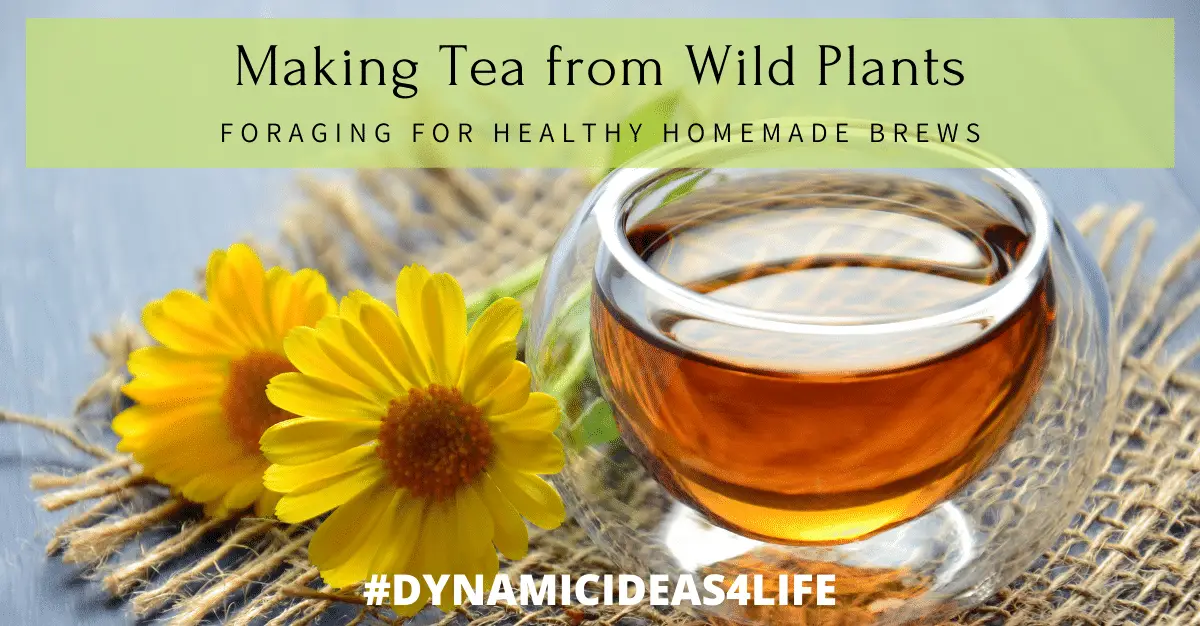Here is an Interesting Idea to think about – Making Tea From Wild Plants! for a healthy drink that not only boosts nutrition but also helps to remedy common ailments like no OTC treatments can.
So I know that to a lot of people this will sound odd and possibly even dangerous but personally I think there is no reason to think this. With the proper research gathering this information is really something that can be very beneficial to learn – if you can pick the right plants the results can be very surprising.
In fact, just the other night, I was thinking about where I can get some fresh mint from to make some Peppermint Tea with.
This is a very good drink for stomach troubles including IBS, Bloating and Constipation.
PLUS another good one is Chamomile Tea which is made from Daisies (if you didn’t know). This gives me some food for thought also.
*Chamomile is a well known remedy for sleep and relaxation.
Now, so besides Peppermint and Chamomile I decided to share this blog as It made me think about what other wild plants can be used to make tea’s and tonics with?
I live in England in Hertfordshire in a suburban area and there is plenty of countryside about. I see many wild plants on my travels and the main plants I thought about picking that grow near me are;
- Peppermint,
- Chamomile,
- Milk Thistle
- Nettles, and
- Dandelion.
These are all very common plants that are for me at least found very easily, and I think for most people they needn’t look any further than in their back, or front garden.
For me there is woodlands near by and crop fields although with the latter I do worry about pesticides etc.
But I am not writing this to put people off but just to simply highlight what some of these plants can potentially do as healthy tonics and remedies. So, let’s begin…
Making Tea from Wild Plants –
Foraging for Healthy Homemade Brews
My inspiration for this post is a few things really. I first wrote about the health benefits of Tea in My Review of the Red Tea Detox by Liz Swann Miller, my research has come a long way since writing this but in conjunction with this my last post about the Best Ways to Stop Snoring was further Inspiration for this.
Mainly because I added a recipe in here for Peppermint Tea.
Now, I have tried Peppermint Tea before. Whilst out in Morocco, I was drinking this most of the time and since then it is something I drink with Mint Tea Bags.
Although, after visiting Morocco I decided I would try and make this myself but also I thought about what other wild plants can be made from wild plants growing in the UK countryside.
This maybe sounds a little bit “Witchy” I know but I really like the idea that brewing some of these wild plants up could help some people who are reading this with their health problems.
Nettle Tea for Hayfever is a big one just to make a quick mention but continuing on let’s take a look at one that may help with detoxing the liver. This is…
Dandelion Tea For Liver Detox

Most people might associate the Dandelion plant as the one which you pick and blow to make a wish. It’s fairy-like white tassels make it a familiar sight in many peoples gardens and really anywhere with grass but also interestingly you can use Dandelion leaves to make a herbal tea.
Many might have heard of the Dandelion and Burdock tonic but actually Dandelion Tea is a healthy drink high in both Vitamin A & K with a number of different benefits.
It can be used to cleanse the liver, improve bone, and skin health, fight urinary tract infections (UTIs) plus it is an ideal remedy for both Calcium and Vitamin K deficiency.
Dandelion Tea is made from the stems, roots and flowers of the dandelion plant. To make this drink first make sure you are picking healthy plants that are in unpolluted areas, and which haven’t been sprayed with anything such as weed killer.
Place a tablespoon of the stems and flowers in boiling water for around 30 mins to brew. Then you can either remove stems and flowers or leave them in your tea.
Alternatively, you can also make Dandelion Root Tea or you can roast the roots to make a kind of Dandelion Coffee.
Benefits of Stinging Nettle Tea

The truth is stranger than fiction. Using Stinging Nettles to make a type of tea is maybe even stranger than the idea of Dandelion Tea but the best thing is if you like Nettle Tea is that Nettles grow all over the place.
From a homoeopathic point of view, Nettles can help with several allergies including hay fever, itching, sneezing congestion, and inflammation.
Other than this it can be used to cleanse the blood, enhance fertility and also Nettle Tea is abundant in a large number of nutrients and vitamins.
These include;
- Vitamin A,
- B Vitamins Including Folate,
- Calcium,
- Magnesium,
- Potassium,
- Iron,
- Amino Acids plus more.
- Nettle Tea also contains many antioxidants and phytonutrients such as betaine, beta carotene, acetic acid, caffeic acid and lycopene.
To make Stinging Nettle Tea take leaves and stem from nettles.
Warning! Do Not Sting Yourself! – Leave to brew in hot boiled water for up to 20 minutes, and then drink.
Homemade Peppermint Tea
OK, I covered this in the last post with instructions to make Peppermint Tea there.
Read Here: Best Ways to Stop Snoring.
Peppermint tea, with its refreshing and invigorating flavor, has been cherished for centuries for its therapeutic benefits and delightful taste.
Making your own peppermint tea at home is a simple and rewarding process that allows you to enjoy a fresh, chemical-free beverage while harnessing the full potency of its natural oils.
Yet, for creating the perfect cup of homemade peppermint tea there is a few things to know.
Why Peppermint Tea?
Peppermint tea is not just a soothing and aromatic drink; it’s also packed with numerous health benefits. Known for its ability to aid digestion, relieve headaches, and reduce stress, peppermint tea is a versatile remedy. Its cooling effect can help alleviate congestion and its antimicrobial properties contribute to oral health.
Plus, it’s caffeine-free, making it a great choice for any time of day.
Growing Your Own Peppermint
The journey to a perfect cup of peppermint tea begins with fresh peppermint leaves. Growing peppermint at home is easy and can be done in a garden, on a balcony, or even in a small indoor pot. Here’s how to get started:
- Choose the Right Spot: Peppermint thrives in a sunny location but can also tolerate partial shade. Ensure the soil is well-draining and rich in organic matter.
- Planting: You can start with seeds, but for quicker results, use cuttings or a small plant from a nursery. Plant them about 18 inches apart to allow for growth.
- Care: Water the plants regularly, keeping the soil moist but not waterlogged. Peppermint can be invasive, so consider using a pot or a contained garden bed.
- Harvesting: Once the plants are established and have plenty of leaves, you can start harvesting. The best time is in the morning when the essential oils are most concentrated.
Preparing Peppermint Tea
Making peppermint tea is straightforward and allows you to enjoy its fresh, vibrant flavor. Follow these steps to brew the perfect cup:
- Harvesting the Leaves: Pick a handful of fresh peppermint leaves. If you don’t have fresh leaves, you can use dried ones, though fresh leaves provide a more robust flavour.
- Washing: Rinse the leaves gently under cool water to remove any dirt or insects.
- Boiling Water: Bring a pot of water to a boil. The general rule is one cup of water per one tablespoon of fresh leaves (or one teaspoon of dried leaves).
- Brewing: Place the washed leaves in a teapot or directly in your cup. Pour the hot water over the leaves and cover. Let it steep for 5-10 minutes, depending on how strong you like your tea.
- Straining and Serving: Strain the leaves out and pour the tea into your cup. Add a touch of honey or lemon if desired.
Enhancing Your Tea Experience
To take your peppermint tea to the next level, consider experimenting with additional flavours:
- Lemon Balm: Add a few leaves of lemon balm for a citrusy twist.
- Ginger: A small slice of fresh ginger can add warmth and extra digestive benefits.
- Lavender: For a calming effect, mix in a pinch of dried lavender flowers.
Storing Peppermint
If you find yourself with an abundance of peppermint, you can dry the leaves for later use.
Hang small bundles of washed peppermint in a dry, dark place until they are brittle to the touch. Store the dried leaves in an airtight container away from light and moisture.
Homemade peppermint tea is more than just a beverage; it’s a ritual that connects you to nature and provides a moment of tranquillity in your day.
Whether enjoyed hot or iced, its crisp, refreshing flavour and myriad of health benefits make it a must-have in any tea lover’s collection. So, take a step towards a more natural and fulfilling tea experience by brewing your own peppermint tea at home.
How to Make Chamomile Tea For Sleep and Relaxation

Chamomile is a name used to refer to several different types of daisy-like flowers. This is actually maybe the most popular type of tea within this post. `It is known to be able to help with many different adverse health issues.
These include;
- Lowering Blood Sugar and Diabetes
- Menstrual Pain
- Osteoporosis
- Inflammation
- Digestive Health
- Trouble Sleeping
- IBS
- Migraines and Headaches
To make Chamomile Tea again same as the above types of teas. Pick xx amount of Daisies (Look for the big one’s if you can). Add to cup or mug. Pour in hot water and leave to brew for up to 20 minutes. Try with Mint or Honey for different flavours.
See the video below for inspiration;
The Incredible Health Benefits of Red Raspberry Leaf Tea
This is a funny one for me because I never really heard of this before doing this research. So, it is funny because if you google Red Raspberry Tea quite possibly the first thing that comes up will be ‘Using Red Raspberry Tea to Induce Labour’.
If you are trying to have a baby this can help apparently plus can also help during pregnancy. Even afterwards as well as it is good for the uterus, and can strengthen the uterine walls.
Other than this Red Raspberry Leaf Tea can also help with cold, & flu, psoriasis, acne, eczema, constipation, indigestion, high blood pressure, inflammation, and joint pain. Plus it also can help with obesity (apparently). {Read More HERE}
It is packed with many different vitamins and nutrients such as Iron, Magnesium, and Potassium plus Vitamin B, C & E.
To make Red Raspberry Leaf Tea. Pick the leaves from Red Raspberry plant. Then it is pretty much the same the other ways of making tea from wild plants, as mentioned above.
You can add the Raspberry in as well. Which are packed with their own detoxifying qualities?
Although it is the leaves that are used for this type of tea.
7# – Other Plants for Making Wild Tea
Upon looking there are some quite strange ideas here. These I will quickly summarize before signing off. One of these I thought was most odd is a type of tea made from the bark of a birch tree!

Yes, this is a thing and is done by collecting twigs and bark from the silver birch tree. You can also use the leaves. Supposed health benefits are said to be skin health and elasticity, a remedy for kidney stones & gall stones plus urinary tract infections.
But this is not even the tip of the Iceberg.
Nature offers a treasure trove of wild plants that can be transformed into delightful and beneficial teas. Foraging for these plants not only provides a fresh and unique tea experience but also connects you to the natural world in a deeply satisfying way.
Some lesser-known wild plants that make excellent teas Include:
Lemon Balm (Melissa officinalis)
Lemon balm, with its mild lemon scent and flavor, is a wonderful herb for tea. Known for its calming effects, it can help reduce anxiety and promote sleep. To make lemon balm tea:
- Harvest: Pick fresh leaves in the morning for the best flavor.
- Preparation: Rinse the leaves and steep a handful in boiling water for 5-10 minutes.
- Flavor: Enjoy it on its own, or mix it with a bit of honey or a slice of lemon for added zest.
Pine Needles
Pine needle tea, rich in vitamin C, has a refreshing, slightly citrusy taste. It’s known for boosting the immune system and providing relief from respiratory issues. When foraging for pine needles, ensure you identify an edible species like Eastern White Pine (avoid Ponderosa Pine and Yew).
- Harvest: Collect fresh, young needles from a healthy tree.
- Preparation: Rinse the needles, chop them slightly to release more flavor, and steep in hot water for about 10 minutes.
- Flavor: Pine needle tea can be enjoyed as is, or with a touch of honey.
Clover (Trifolium spp.)
Both red and white clovers are common wild plants that can be used to make a mild, sweet tea. Red clover is particularly known for its potential benefits in supporting women’s health.
- Harvest: Gather the flower heads and leaves, preferably in the morning when they are fresh.
- Preparation: Rinse the flowers and leaves, and steep a handful in hot water for 5-7 minutes.
- Flavor: Clover tea is naturally sweet and doesn’t usually need additional sweeteners.
Linden (Tilia spp.)
Linden, or lime tree blossoms, produce a floral, slightly sweet tea that is traditionally used to relieve stress, promote relaxation, and soothe colds.
- Harvest: Pick the flowers and associated bracts when they are in full bloom.
- Preparation: Rinse and steep a small handful of blossoms in hot water for 5-10 minutes.
- Flavor: Linden tea is delicate and pairs well with a bit of honey or a slice of lemon.
Yarrow (Achillea millefolium)
Yarrow tea has a slightly bitter, herbal taste and is known for its anti-inflammatory and digestive benefits. It’s a hardy plant that grows in a variety of conditions.
- Harvest: Collect the flowering tops and leaves.
- Preparation: Rinse and steep a teaspoon of dried or a tablespoon of fresh yarrow in hot water for 10 minutes.
- Flavor: Due to its bitterness, yarrow tea is often enjoyed with a bit of honey or mixed with other herbs like mint.
Wild Bergamot (Monarda fistulosa)
Also known as bee balm, wild bergamot has a spicy, citrusy flavor and is known for its antimicrobial properties and ability to relieve respiratory issues.
- Harvest: Gather the flowers and leaves when the plant is in full bloom.
- Preparation: Rinse and steep a handful of fresh or dried wild bergamot in hot water for about 10 minutes.
- Flavor: This tea is delicious on its own but can be enhanced with honey or a slice of orange.
Foraging Tips
When foraging for wild plants to make tea, always ensure you:
- Properly Identify Plants: Use a reliable guidebook or consult an expert to avoid toxic look-alikes.
- Harvest Responsibly: Take only what you need and leave enough for the plant to continue thriving.
- Avoid Contaminated Areas: Steer clear of areas that may be contaminated with pesticides or pollutants, such as roadsides and industrial sites.
Experimenting with wild plants for tea can open up a world of flavours and health benefits. Each plant offers its unique taste and medicinal properties, making every cup of tea a new adventure in natural wellness.
Final Word
Last night I finally tried my hand at making Peppermint Tea. Something I need to work on I think to try and make a more potent brew. Maybe will try brewing alongside my Chinese Black Pu’er Tea with a bit of Ginger and Honey.
Other than this I really would like to try making Chamomile Tea. This I bet would save me a fortune on Tea Bags lol. I like a nice long walk through the fields, and nature trails near to where I live so no doubt will find some to pick somewhere.
Although, I am not to keen on the idea of dandelion tea though I don’t think, or the birch bark tea but all in good time. The Bergamot one seems like a not too crazy idea though – I might give that a try as well.
All, I will say to people, and I should have written this at the top really – be careful with which plants you pick! If you pick the wrong one’s they could be poisonous.
Also, another problem can be if these wild plants have been sprayed with anything such as weed killer. Look for healthy-looking plants in places like meadows etc.
And on that note. I shall finish this article up here but if you have enjoyed reading please don’t hesitate to leave a comment below.





Anxiety and Depression best ways to lower blood sugar BiOptimizers blood pressure supplements blood sugar support supplements Digestive Enzymes Supplement digital products Dr Sam Robbins Exercise Gut Health Healthy Living heart health HFL how to lower blood sugar levels How To Lower Cholesterol how to strengthen the immune system insulin resistance joint health supplement Keto keto dieting Keto Diet Weight Loss leaky gut supplements leptin resistance list Magnesium deficiency Matt Gallant mental health multivitamins Nootropics nutrient supplements Probiotics Probiotic Supplements proteolytic enzymes reverse type 2 diabetes stress and anxiety stress relief vitabalance vitamin c vitapost Wade Lightheart weight loss articles weight loss diet plans weight loss product reviews weight loss supplements weight loss tea








Learned something new today, as I never realized that Chamomile tea was made from daisies. I love to have Chamomile tea at night just before I retire as it really relaxes me and helps me to sleep better.
It was interesting to read that one can also make one’s own Dandelion Tea, and it seems to have wonderful benefits for the body. I would just be interested to know how it actually tastes and would you drink it black or with milk?
Hi Michel, Thanks for taking the time to comment. I didn’t know that Chamomile tea came from daisies till very recently either. I still have not tried yet but think I would like to soon.
As for dandelion tea yes it does seem to give a lot of health benefits. I would say drink it black but you may be able to drink with milk not really sure.
Hello there this is an amazing review you have got here. i am sure that the quality information in this post will be of great help to anyone who come across it as it to me this really caught my attention as i was scrolling through it i just could not it i havent really tried out any of this tea before but i am sure going to try it out after now thanks for sharing the info with me
Hi Joy, Thanks for taking the time to comment. This is an interesting post, isn’t it. Very much enjoyed writing it.
Hello there, thanks for sharing this awesome article i know it would be of great help tot he public as it has been of help to me. Although i am just hearing this for the first time i think i can still give it a trial as home made remedies have really proven to be the best among all.
Hi Isme, Yes I think that what is in wild plants might surprise people. I was shocked about finding out about what is in dandelions but so many ideas to try here. I myself am still deciding what to try next although I really want to try making chamomile. Everywhere I’ve been past few days been eyeing up the wild plants lol
Thank you for your post. It is useful for me. I heard about making tea from wild plants from my friends, who informed me to looking for recipes in the internet. But I never take time to do it.
Here comes your article, which is all info I need to make tea from wild plant. I particularly like your recipe of dandelin tea detox. My friends informed me that it is good for urinary infections, which is the problem I often encounter. I am so happy that it is so easy to make. Right now it is winter for us and I will try to buy some dandelion tea. Next spring, I will make my own dadelion tea to detox my body.
Hi Anthony, Try the supermarkets I see there are quite a few differences here. It’s also winter for me in the UK so probably will leave to the spring and summer before foraging again.
Hi there,
I love your article; It is so agreeable to read! Thank you!
I drink camomille every day, and I knew it is excellent to calm down and improve slipping, but I didn’t know that it has other virtues. I’ve never tried the Red Raspberry tea, and I think it’s time to do it. I have joint pains, and I need something to help with it. Will they lose their virtues if I mix two tea flavors? I am always trying new things, but as tea is quite expensive, I don’t want to take any risk.
Thanks a lot!
Hi Daniella, Glad you liked. I drink Chamomile also but I’ve only ever made from wild daisies once. Red Raspberry, I am yet to try but I have a box from the supermarket of Berry teas. As, for mixing 2 types I don’t know really I drink different types throughout the day. I don’t really consider the health benefits but I’ve kind of grown accustomed to the flavours. As for price – I buy my different tea from Aldi in the UK £1 a box. I see there are all the twinning branded teas that are more pricey but if you know what to look for outdoors this is the best value.
I like your organic approach. It is quite fascinating to hear how different plants and more specifically flowers can make certain teas. The process behind this is even more mesmerizing.
It is very refreshing to hear about the benefits of drinking the teas and how you can make and drink once you’re done.
This is the type of content that needs to make its way into mainstream media, such as The New York Times or Oprah Magazine. Matter of factly, I plan on using some of these formulas after considering the immense health perks.
If anything, I want to more about these gleefully unconventional, yet resonant flower tea recipes. More is better.
I found this post very engaging and helpful. Great job!
Thank you. Glad I can help.
I love this article you made my day. I am one person who can take a table spoon of ACV . Yes It has a bad taste and is very bitter. But it does wonders to maintain my weight, hair, and skin. I am just Beautiful by using ACV. I didn’t realize it came in all those flavors. I don’t go to the health food store. Your article told the whole story about ACV it was fantastic. Just about everything you named in your article I use and take. I am older so I am trying to preserve my youth. Do the gummies ACV have a bitter taste? They look good.
Diane I think you have commented on the wrong article. Do you mean this one;
VitaPost ACV Pure Review – Apple Cider Vinegar Dietary Supplement – (dynamicideas4life.com)
It’s nice that you live in a place where plants and herbs are easily accessible to make homemade brews. The only stuff I could get around here is peppermint leaves which don’t really taste that great compared to the commercial ones. Maybe my technique was wrong. How do you do yours? Boil it in hot water or just let it steep?
Hi Cathy, Yes I kind of crush them up a bit then leave in a jar of boiling water for half-hour and after that heat back up in a pan. I know what you mean about flavour – try mixing with lemon and honey for better taste.
Hi there, thank you for this wonderful article. I have to admit. I never knew you could make tea from dandelions. I knew that you could make wine from them. LOL, and then the added benefit of vitamin A and K. I’m definitely putting this on my to-do list. As soon as spring hits and the dandelions start coming up, they will go into the teapot.
Hi John, Thank you for your kind words. Dandelion tea I have not personally tried but it is for sure a thing. I think come spring I will try making my own also😎
I love this article! As a family who enjoys both coffee and tea every day, your article brings up some interesting ideas! We already enjoy the varieties you mention, but the thought of making them ourselves, from the wild plants, is even more intriguing!
Since our farm is organic, it’s very possible for us to use plants from our own farm. This might even be a fun family project to begin our New Year in a different mode.
Thanks for the ideas. You’ve given me an article that I can easily share, too! I’ve added to my Twitter and Facebook!
Thanks, Diane, Always appreciate shares on Social Media. Hope you have fun foraging – will wait to the spring I think but keen to try some new ones later this year.
Hello there, thank you so much for sharing this. this is a very awesome piece and a very detailed one. I’m really happy I came across this. Reading about this article making tea from wild plants sounds really interesting. I never knew one can make tea from a wild plant but going through this article was indeed an eye opener and I enjoyed reading this article
Thank you Charity, I had heard of Mint Tea before but never really any of the others really caught my attention much. At the time of writing this article though I learned that chamomile tea was made from daisies and this really kind of was the inspiration.
Reading your essay was a true pleasure for me. Your writing style simplifies even the most intricate subjects. I really appreciated the helpful pointers you provided. Your time and insight are much appreciated.
Thank you much appreciated.